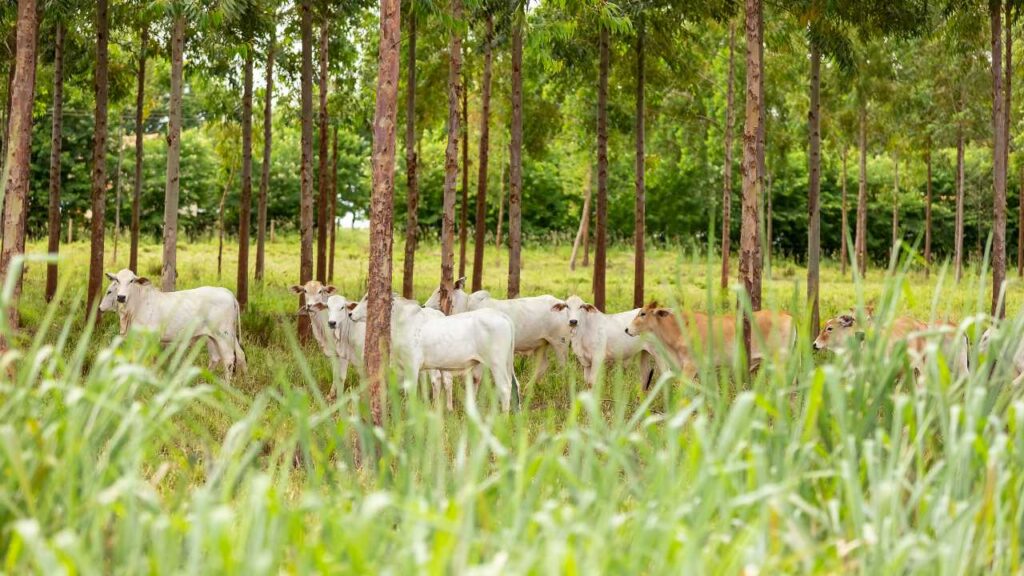Technologies and practices that combine productive efficiency and environmental care for a more sustainable future in agriculture.
Did you know that integrated systems can increase soil carbon stock, preserve production areas while optimizing productivity?
The conversion of forests into intensive agricultural areas, with the use of fires and improper management, has intensified environmental impacts. These activities increase greenhouse gas (GHG) emissions, degrade the soil and reduce ecosystem services, especially in degraded pasture areas.
The adoption of integrated systems, such as integrated crop-livestock-forestry (ICLF), for example, can reverse this scenario. However, the environmental benefits offered by these systems depend on the management choices, taking into account the vegetation and climate of the place. Want to know more about this topic? Keep reading.
_______________________________________________________________________
Learn more:
Regenerative Agriculture: The Path to Sustainable Production
_______________________________________________________________________
But, after all, what are Integrated Systems?
Integrated agricultural production systems are management strategies that combine crops, livestock, and forestry in the same area. The main objectives are: to recover degraded pastures, increase productivity and optimize ecosystem services.
Four main types stand out:
- Crop-Livestock-Forest Integration (ICLF): System that integrates agricultural crops, pastures and forests (or tree species of ecological or economic interest), implanted in the same area. It is considered the most complex system among the integrated systems, as it aggregates three productive components.
- Crop-Livestock Integration (ICL): System in which agricultural activities such as cereal and legume cultivation and livestock are integrated sequentially, simultaneously or rotationally, in the same area. Its main objective is to maximize the efficiency of biological cycles through the interaction between plant and animal components, such as the use of organic waste.
- Livestock-Forest Integration (ILF): Integrates pastures (animal production) with forest species, in intercropping, rotation or succession. The focus is to offer microclimatic benefits to animals, such as promoting thermal comfort.
- Crop-Forest Integration (ICF): It consists of the integration between agricultural crops and forest species in the same area. This system seeks to take advantage of the ecological effects of the forest — such as improved microclimate, soil conservation, and increased biodiversity — associated with agricultural production.
The choice of the system and the time of use of each component depends on the production objective and regional characteristics. Thus, integration becomes an efficient tool for more resilient agriculture.
_______________________________________________________________________
Find out more:
Soil Health Map of Latin America Reveals Challenges and Solutions for Sustainability
_______________________________________________________________________
The use of Integrated Systems for carbon sequestration
The use of integrated agricultural production systems has shown a fundamental role in increasing the concentration of carbon in the soil. Its use acts to reduce climate impacts and soil degradation.
Several studies have shown that the conversion of degraded pastures to systems such as ICLFS can significantly increase carbon accumulation.
In a study that evaluated the recovery of pastures in the Cerrado, these gains were observed in the soil layers, with an increase of up to 212% in the contents. In addition, the stock of organic carbon in the soil was 146% higher in the integrated systems. These data reinforce the potential of these agricultural practices to sequester atmospheric carbon and store it in the soil over time.
_______________________________________________________________________
Learn more:
Sustainable Management for Methane Emission Reduction in Rice Cultivation
_______________________________________________________________________
Studies show that the introduction of trees, such as eucalyptus, and grasses with high biomass and developed roots add to the accumulation of organic matter in the soil. The constant deposition of organic residue, on the surface and at depth, provides carbon-rich materials to the soil-plant system. These materials contribute to the formation and stability of organic carbon, promoting soil health and fertility over time.
Advantages of integrated systems in improving Soil Health
The adoption of integrated systems, such as ICL, ICLF and IPF, has significantly increased the Soil Health Index (ISS), especially in areas of sandysoils. This index brings together physical, chemical and biological indicators, allowing a more complete assessment of the functionality of the soil. Thus, it is possible to identify the advantages and disadvantages of adopting different types of management.
Some commonly used practices are the inclusion of forage species with deep roots, the maintenance of vegetation cover and the efficient use of organic waste. These techniques offer benefits such as the accumulation of organic carbon, improvement in water infiltration and retention, and stimulation of microbial activity. One of the factors observed was the increase in microbial biomass and enzymes β-glucosidase and urease in areas with greater species diversity.
The association of legumes such as pigeon pea with grasses and trees (Eucalyptus urograndis) in silvopastoral systems promotes biological nitrogen fixation. This combination also contributes to soil structure at different depths.
These factors increase the ISS, indicating improvements in soil structure, water retention, and nutrient cycling. In addition, proper management, such as controlling animal stocking and crop diversification, prevents compaction and degradation. Adherence to these techniques contributes to a more resilient and sustainable production system in the long term.
Challenges and opportunities of implementing Integrated Systems
Despite the numerous benefits of integrated systems for soil health and agricultural sustainability, their large-scale implementation still faces several challenges.
Barriers such as traditionalism and resistance to the adoption of new technologies make it difficult for many producers to join. In addition, the requirement for higher technical skills and high initial investment costs limit large-scale implementation.
Programs such as the ABC+ Plan (Plan for Adaptation and Low Carbon Emissions in Agriculture) encourage the advancement and adherence to more sustainable management. However, it is essential to expand investments in research and training to enable the quantification of carbon sequestration and the reduction of GHG emissions.
In this context, researchers from CCARBON/USP have developed studies and tools to overcome these barriers. Through data, practical solutions and technical support seek to collaborate with the adoption of more sustainable systems in the field.
Final remarks
Integrated systems stand out for promoting more efficient property management, encouraging correct environmental practices and ensuring income diversification. By integrating the production of grains, meat, milk, timber, and other products, these systems increase job creation and economic stability.
These production strategies not only increase productivity but also promote improvements in soil health, reinforcing its key role for sustainable agriculture.
References
Alves, M. A., dos Santos Braz, T. G., de Freitas, I. C., Pena, A. N. L., de Resende Ferreira, K. D., Albuquerque, C. J. B., … & Frazão, L. A. (2023). Evaluation of Buffel Grass Forage Production, Soil Microbial Biomass, and Enzymatic Activity in Silvopastoral Systems. Rangeland Ecology & Management, 90, 56-63.
Anésio, A. H. C., Santos, M. V., Dumont, M. A., Barboza, J. A. D. S., Frazão, L. A., Teixeira, R. B., … & Silva, K. P. E. (2024). Management of marandu grass pasture increases soil carbon and nitrogen stocks in silvopastoral systems in the Brazilian Cerrado. Revista Brasileira de Ciência do Solo, 48, e0240057.
Balbino, L. C., Kichel, A. N., Bungenstab, D. J., & Almeida, R. D. (2012). Sistemas de integração: o que são, suas vantagens e limitações. Sistemas de integração lavoura-pecuária-floresta: a produção sustentável, 2, 11-18.
Carvalho, P. C. D. F., Moraes, A. D., Pontes, L. D. S., Anghinoni, I., Sulc, R. M., & Batello, C. (2014). Definições e terminologias para sistema integrado de produção agropecuária. Revista Ciência Agronômica, 45, 1040-1046.
Cerri, C. E. P., Abbruzzini, T. F., Oliveira, D. M. S., Ferreira, T. O., Ruiz, F., Azevedo., A. C., … & Maia, S. M. F. (2025). O protagonismo da agropecuária brasileira na mitigação das mudanças climáticas. Interesse Nacional, 69, 49-58.
Freitas, I. C. D., Alves, M. A., Pena, A. N. L., Ferreira, E. A., & Frazão, L. A. (2024). Changing the land use from degraded pasture into integrated farming systems enhance soil carbon stocks in the Cerrado biome. Acta Scientiarum. Agronomy, 46, e63601.
Poppiel, R. R., Cherubin, M. R., Novais, J. J., & Demattê, J. A. (2025). Soil health in Latin America and the Caribbean. Communications Earth & Environment, 6(1), 141.
Silva, L. J. D., Freitas, I. C. D., Abreu, L. H. G. D., Oliveira, D. M. D. S., Barbosa, D. L. D. A.,
Figueredo, C. C., … & Frazão, L. A. (2024). Converting Low-Productivity Pasture to Well-Managed Pasture and Silvopastoral System Cause Relevant Changes in Soil Chemical and Microbiological Characteristics. Forests, 15(6), 1029.
Vanolli, B. D. S., Dias, H. B., da Luz, F. B., Lamparelli, R. A. C., Magalhães, P. S. G., & Cherubin, M. R. (2025). Crop–Livestock Integrated Systems Improve Soil Health in Tropical Sandy Soils. Agronomy, 15(2), 378.





